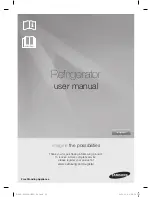
Problem
Possible Causes
Solutions
The appliance does not operate
•
There is a power failure
•
The appliance is not plugged in
•
A fuse has blown or the circuit
breaker is tripped
•
Ensure the appliance is plugged in and
the power outlet has power
•
Replace the broken fuse or reset the
breaker
enough
The appliance is not cold
The set temperature too high
•
•
The appliance is placed too close to
a heat source
•
The door is opened too often
•
The door is not closed completely
•
The door gasket does not seal
properly
•
The front bottom grille does not
have sufficient ventilation
•
Adjust the set temperature
•
Keep the appliance away from sunshine
or other heat sources
•
Close the door tightly and do not open
the door too frequently or for a long
period of time
•
Ensure the door gasket is not loose. The
front bottom grille must be completely
unobstructed
•
Decrease or increase the ambient
room temperature
•
To minimize internal temperature fluc-
tuation, do not add large amount of
contents at once.
Close the door tightly and do not open
the door too frequently or for a long
period of time.
•
Ensure the door gasket is not loose.
•
The ambient room temperature
is too low or high
•
A large amount of contents has
been added to the appliance
•
The door is opened too often
•
The door is not closed completely
•
The door gasket does not seal
properly
The appliance makes too
much noise
•
The noise may come from the flow of
the refrigerant and ex pansion of the
inside walls may cause popping and
crackling noises
•
Contraction and expansion of the
inside walls may cause popping and
crackling noises
•
The appliance is not level
The door does not
close properly
•
The appliance is not level
•
The door was reversed and not
properly installed
•
The shelves are out of position
•
It is normal that as each cooling cycle
ends, you may hear rattling or
gurgling sounds caused by the flow of
refrigerant in the appliance. The high
efficiency compressor may make a
pulsating or high pitched sound.
•
Some popping or cracking noises are
normal. They are caused by expansion
and contraction of the inside walls due
to temperature changes.
•
Make sure the unit is on a hard and
level surface. Do not place the
appliance on carpet.
•
See Operating Noises.
•
Make sure the appliance is on a hard and
level surface. Avoid placing the
appliance on a carpeted or soft surface
•
Correctly install the shelves
Troubleshooting
The appliance turns itself
on and off frequently
1
4


































